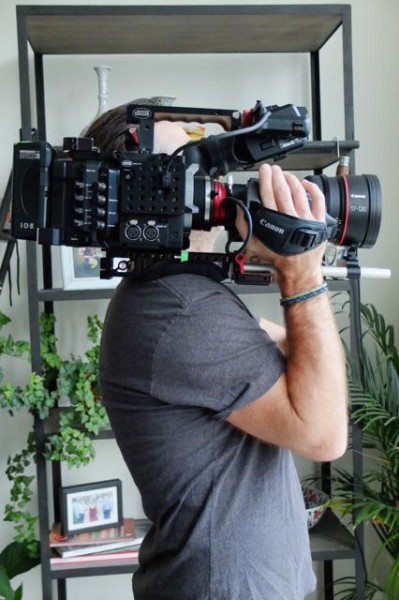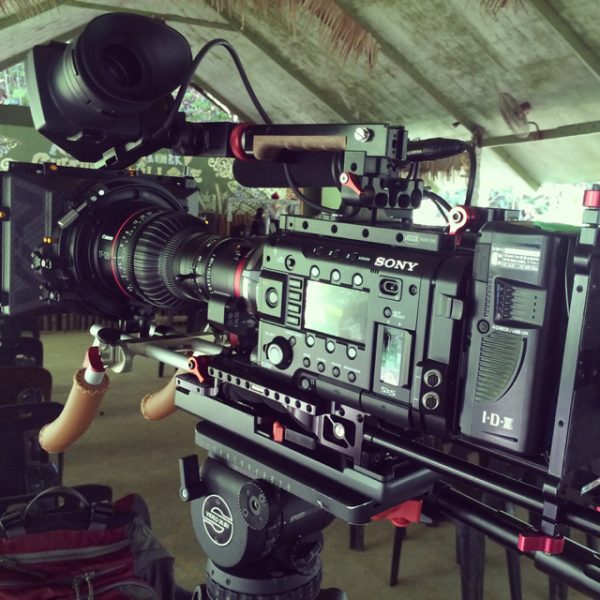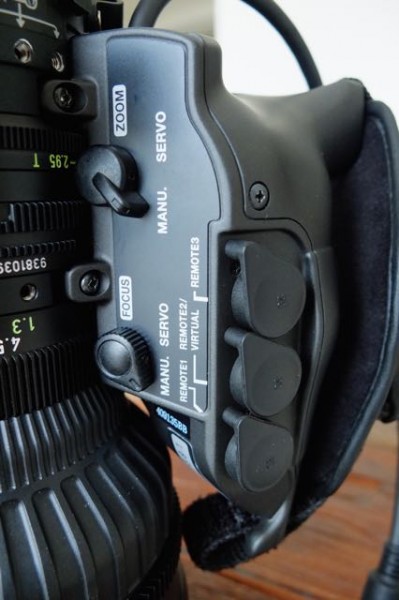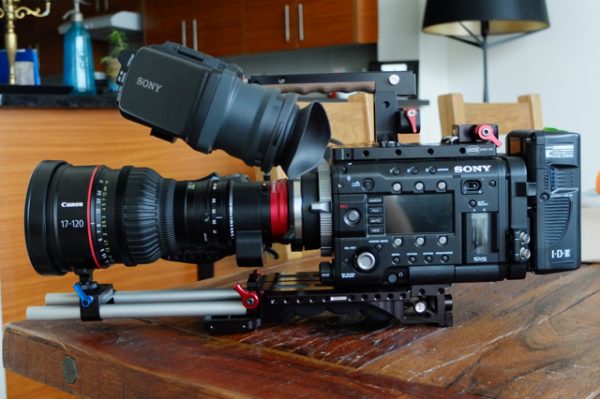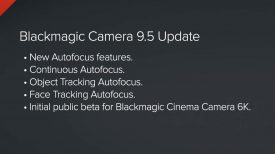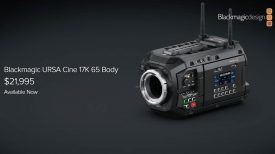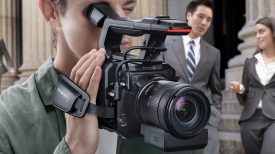Guest post by Ben Emery:
To call this a review of the Canon CN7x17KSA cine-servo zoom lens is probably not technically correct. I’m not a lens expert; I don’t shoot charts or count lines of resolution. If you want that detail, I’m sure it’s out there somewhere on the web. This article is my thoughts on this lens from the point of view of a shooter who’s been working with this lens for the last month or so. I’m not on the pay roll of Canon, they haven’t given me this lens for free, they didn’t even loan it to me for this evaluation. I bought it with my own money – a lot of my own money. Which brings me to the first point; a lot of people complain this lens is too expensive. B&H list it at $31,350 US and that is a significant investment for any owner operator. The DSLR revolution and subsequent flood of high quality affordable cameras has drastically reduced the cost of entry to this game. But the plummeting cost of cameras hasn’t necessarily been matched by the price of lenses. A lot of people in the low to mid end of this business, including many people working in broadcast TV who have made the swap to shooting on S35 digital cameras, are making do with using photographic lenses. Stills lenses are fine in many circumstances but all have their limitations.
The way I see it, at $31,000 the Canon CN7x17 is actually a bargain. Its closest competitor in specs is the Fujinon Cabrio 19-90 T2.9 and that’s listed on B&H at USD $39,800. Only a few years ago s35 cinema lenses with this focal range would have been hugely expensive (not to mention just plain huge!) In the broadcast world, where I’ve been working for the last 17 years, B4 mount 2/3inch lenses were the go-to lens. A standard DigiBeta or XDCAM Documentary kit would have included 2 lenses like the Canon HJ22x7.6 and Canon-HJ14x4 with a price tag of $37,000 US and $35,000 US respectively. I’m not saying that the cost of the CN7x17 is chicken feed, but I’m a professional, I make my living out of this equipment, I need professional equipment and my clients expect it. I’m prepared to pay for that and I charge accordingly. In the era where the latest camera tech is redundant in 18-24 months, an investment in glass is a much more long term proposition. Lens technology has moved a lot slower than cameras, but I hope we continue to see the price/size/weight drop in the coming years.
Okay: enough about money, on to the lens itself. The Canon CN7x17KASS is a 17-120mm T2.95 “cine-servo” lens. As the name suggests it has a class leading 7x zoom range. The “cine” in the name refers to the fact that it’s a “cinema” lens with a S35 covering image circle of 31.7mm. The “servo” refers to the fact that the lens includes a broadcast style servo for control of zoom, focus and iris. It’s the servo that I think points to the true target market for this lens – the Broadcast sector. For years, Canon B4 mount lenses like those mentioned earlier were the staple of broadcast crews. Since the DSLR revolution, many like myself have changed over to Super 35mm sensor cameras like the C300, F5/55 and Amira, but without a viable zoom lens option. Canon has obviously drawn on its years of experience building ENG/EFP B4 lenses and cinema zooms to build this hybrid lens just for us.
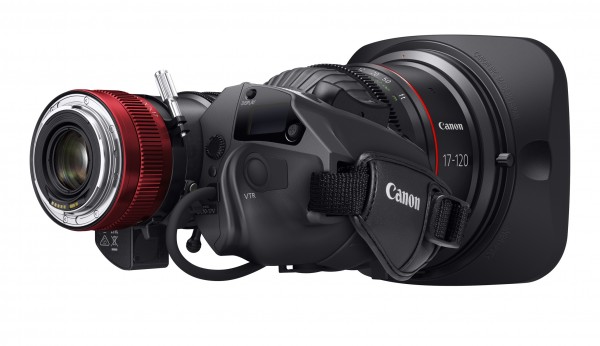
It comes in either PL mount or EF mount. The mount is exchangeable between the two but only by a Canon service centre and at a cost. This is because there are a bunch of electronics built into either mount, but more on that later. Clearly it’s not something you’ll be doing all the time, but it’s handy for protecting your investment if and when you change camera systems. It will be interesting to see if Duclos lenses develop a user changeable “multi mount” like they do for the Canon 15.5-47 and 30-105. I would imagine that this will come at the cost of the inbuilt electronic interface but fingers crossed.
The lens has an 11-blade iris and this has become standard across Canon’s cinema lens line. An 11-blade iris reduces highlight artefacts and helps produce beautiful round out-of-focus bokeh.
The lens is 4k compatible and as mentioned previously covers an image circle of 31.7mm. That has us covered for the Super 35mm and most cameras currently on the market. But it won’t cover a full frame camera like the 5D. I’ve had no experience using it on a RED Epic or Dragon. From what I’ve read, it will cover the Epic’s Mysterium-X 5k sensor but there are some issues with Dragon at 6k. Mathew Duclos posted this on the topic over at reduser.net
“6K Full Frame – Hard corner clip @17mm. By 40mm, soft vignette and usable
6K 2:1 – Practically same as above
6K Widescreen – Soft vignette @17mm, ok by 20mm
6K HD – Covers well, very minor light falloff (expected) at 17mm
Anything less than the 6K HD frame size on the Dragon and you’re all good.”
Calling it a T2.95 is not strictly accurate – it’s actually a T2.95-3.9 as the lens does exposure ramp 1/2 a stop as you zoom. However the ramp only occurs in the last 30mm of the zoom range, from 90-120mm. Some shooters I’ve spoken to consider this a deal breaker. For me, it’s not a big deal. I consider it a small price to pay for such a wide focal range.
The focus throw is 180 degrees. This differs to the rest of Canon’s cinema lenses, which all offer 300 degrees rotation. I’m told this is all they could manage with the torque limitations of the compact and light weight servo motors. Some of the cinema guys may not be happy with this, but for me it’s a plus. 180 degrees is a much more manageable focus throw for the single person operator working without a focus puller or, indeed, a follow focus. I’ve tried doing a focus pull on a lens with a 300 degree throw and it requires a high level of contortion of your left hand and arm. The focus barrel has markings in both feet and metres.
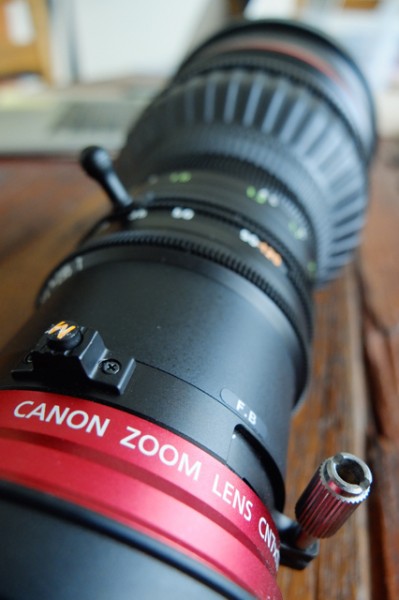
The lens also includes a macro focus adjustment and back focus adjustment like the ENG lenses. This is a pretty unique feature for a cinema lens (I think) and super handy as it allows focusing to within a few inches of the front element of the lens. The focus barrel has two sets of gears. There’s the cinema standard .8 pitch so you can use a follow focus or 3rd part focus motor and a .5 pitch gear for the servo to drive. However, the zoom only has the .5 and the Iris .4 pitch gears. Again, this might annoy the cinema folks hoping to use their Preston motors on the lens to control zoom and iris in remote applications, but I’m sure it’s relatively easily overcome with adaptor gears or rings. For us broadcast guys (and girls) it’s not a problem; the servo has everything we’re used to for remote operation. In the base of the servo grip are 3x 20 pin Hirose connectors that allow connection of industry standard focus and zoom demands. Ideal for a studio or crane set up. The third port is for a 16bit Met data output for some hi-tech trickery I don’t really understand. The Servo itself is an impressive bit of tech with full digital control via a small LCD panel and joy stick control built into the unit. It allows you to make a heap of adjustments to the speed of the zoom and its start and end points as well as program set and repeatable moves. For less precise adjustments of zoom speed there is also an easily accessed dial located just to the left of the record trigger that we ENG shooters will be familiar with. Zoom speed can be set to a minimum of .5 second, going up to a maximum of 300 seconds.
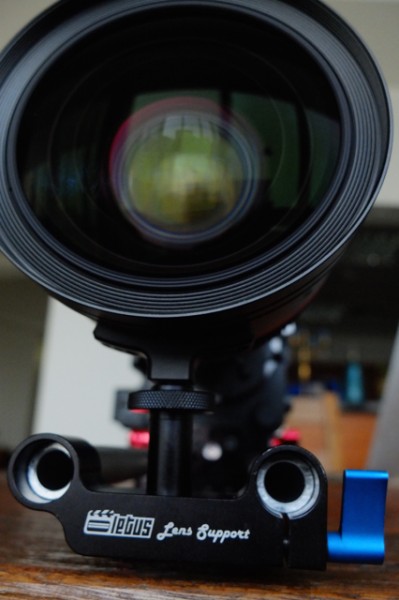
Attaching the CN7x17 to the camera body is as straightforward as mounting any PL or EF lens, though I would highly recommend using a lens support so as not to damage the mount. The lens includes a 1/4 20” mounting hole and a separate 3/8 16” adaptor for using your choice of support. Personally I use the Letus quick snap lens support and it works great. Providing power to the lens and receiving data from it depends on the choice of mount as well as the type of camera you’re using. The good news is that most options seem to be covered. Firstly, the PL mount, as that’s what I’m familiar with. There are two options for power and data in this configuration, the first is via a standard 12 pin Hirose connector familiar to users of B4 ENG style lenses. On cameras such as the Arri Amira you simply plug the connector into the camera and away you go with power to the servo, lens data in the VF and record trigger via the servo grip. On cameras where the 12 pin connector is not used, like the Sony F5 and F55 you simply plug the connector back into the lens and then it passes power and data through the Cooke-i technology ports built into the lens mount (you need to first enable ‘Type-c’ on the camera menu under ‘lens interface’). Again, you have servo power, lens data in the VF and record stop/start control. For lenses with an EF mount things get a little complicated. With a EF mount camera such as Canon’s own C100/300/500, data from the lens passes through the mount and will appear in the VF/LCD. However, power for the servo will not, nor will (I believe) the record trigger on the lens. To power the lens from a C series EF mount camera you need to use an external power source like a V-lock or gold mount battery and an adaptor cable from D-Tap or Lemo (or whatever your power source has) to the 12-pin Hirose. Fortunately there are lots of these cables about – try e-bay for a start. If you think it’s strange that the full functions of the Canon lens isn’t available on the Canon cameras you’re not alone. I can only assume that when Canon developed the electronics in the EF mount it was purely for stills camera functionality. No one would have ever envisaged needing to power a lens like this. Whether it is addressed in future Canon Cinema EOS cameras I can’t say. For further information on how to set up this lens with different cameras, check out this video from Able Cine:
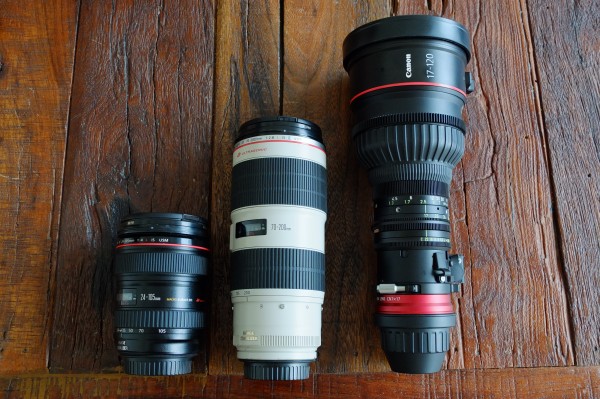
In the brochure, Canon describes the lens as “compact and lightweight”. While I take its point that in the world of cinema the lens is positively a miracle of miniaturisation, in my world it’s a total beast in both size and weight. Canon claim the weight at 2.9kg (6.4lb), but either it’s being optimistic or my lens got stuck in to some Katsu curry on its way from Japan to me. By my scales, the lens weighs just over 3.1kg with servo and 2.9kg with servo removed. It’s also long at 254.9mm in PL mount (EF is a bit longer) and without lens hood attached. That’s a porker in comparison to its competition; the Fujinon Cabrio is 223mm in length and 2.7kg (servo attached). Canon’s own 15.5-47 Cine Zoom is 214mm and 2.2kg and the old B4 work horse the HJ22x is 219mm and a featherweight 1.6kg. In defence of the CN7x17, it has a larger zoom ratio than the first two lenses and of course covers a S35 sensor as opposed to the HJ22x’s 2/3inch. But its length makes shooting in tight places like a car interior difficult, and the weight makes it difficult to achieve a balanced rig on the shoulder. Adding to the second point is the fact that the bulk of the weight of the lens is located in the front third (ie behind the front element). As I said, it is difficult to achieve balance; not impossible. This depends largely on the camera you have behind it and the accessories you use. I shoot on Sony’s F55 and use the Zacuto Z-VCT base plate. This allows me to push the camera a long way back so the point where the lens mounts to the body is just about on top of my shoulder. This in turn means I need to push my EVF forward. For this, I use the Vocas top handle which I mount backwards putting the EVF in just the right position. This setup is very balanced and I find, despite the fact it weighs about 11kg (fully rigged with matte box, V-lock battery, radio RX etc), I can comfortably hand-hold it much longer than I can a lightweight C300 rig. Like, I said this works for my rig on the F55. I’d imagine achieving a “balanced rig” with a camera as small as the C300/500 or the FS7 would be quite challenging. Conversely, I’d love to try it out on the Amira as I think the extra length and weight of the Amira would make it a pleasurable combo to use.
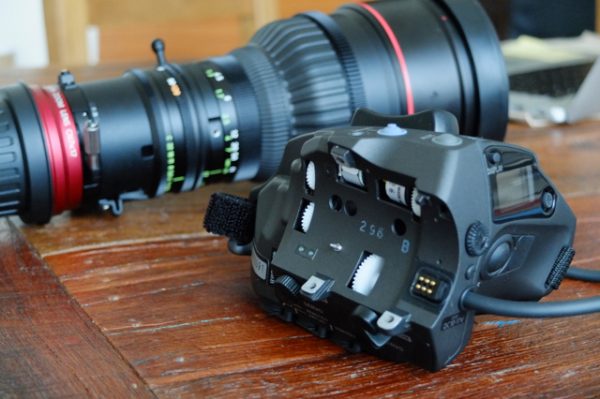
Pushing the camera back this far does have its drawbacks. The whole combo is so far back that the servo control is too close to your head to comfortably hold onto. I find that after extended shooting with the servo grip in this configuration my right arm fatigues quickly. I personally don’t find this a big deal. I’ve never really been a fan of servo zooms and prefer to operate the lens manually in “cinema mode” so I remove the servo and attach a set of moose bars to the 15mm rods instead. The servo is easily removed: just three screws and it’s off. There are convenient “storage” holes so the screws can be screwed back into the body of the lens for safe keeping and also a dust cap for the electronic interface. Reattaching the servo is a similarly easy 60-second job – just line it up and screw it down. Canon claim that there is no need to recalibrate the servo once attached. The first time I removed mine and reattached it, I found that it wouldn’t zoom through the entire range using the servo, stopping around 50mm. There is a simple procedure outlined in the manual to recalibrate the servo to the lens. It involves entering the menu on the LCD of the servo unit. It’s a straightforward process and once completed my lens worked fine again. One complaint I do have with the lens is that when the servo is removed the iris ring is un-dampened: it has almost no resistance in its movement, making it very easy to accidentally bump when operating the camera. With the servo attached, this isn’t an issue, with the servo mechanics providing some level of damping to the iris ring.
Shooting with the lens is a real pleasure. The ergonomics and layout are really well designed. The iris, zoom and focus rings are located closely together and fall easily under your thumb, index, middle and ring fingers. This makes adjustments to exposure, framing and focus really quick and means your hand isn’t constantly moving up and down the lens barrel to make adjustments, potentially introducing unwanted camera shake. It might sound a strange thing to make a point of, but I’ve shot regularly with the Zeiss LWZ.2 zoom and compact zooms (CZ.2) as well as the Angenieux Optimo DP series and found the spacing of the iris, zoom and focus rings not as instinctive. In run-and-gun, off the shoulder situations this sometimes resulted in me accidentally adjusting framing when I meant to be adjusting focus.
Like I said at the start of this post I’m not going to go into technicals about the image quality. I’ll leave that to others far more qualified than me. But my thoughts are that it’s sharp – very sharp; to my eye much more so than my L series zooms. I can’t see any degradation in the image quality at any apertures or focal lengths. (I’m sure some pixel peepers will point out where I’m wrong here with resolution charts and 100% image crops to back them up. I’m sure they’re right. I’m just talking about how it looks to me). I find it has the same creamy, almost ‘romantic’ look in saturation and contrast that you find across the range of Canon lenses. I’ve had no problems matching it to my other Canon glass. The lens has some lovely flare properties. I wouldn’t say it flares easily or excessively like some older lenses, but when it does it’s a pleasing result. There is some focus breathing present, but it is minimal and I find it well with in the realm of acceptability.
Do I like the Canon CN7x17 and is it worth the money? Yes. Of course I’m going to say that – I’ve laid down a lot of my hard-earned cash for it. But honestly, this lens is a dream and is something I’ve been waiting for since I was swept up by the DSLR revolution all these years back. As a documentary shooter, having one lens that covers a focal range of 17-120 makes it perfect for the majority of work I do. No more being caught out on the wrong lens, or worse still, being caught out whilst changing lenses. You could almost shoot with just this lens. In fact, I recently did on a documentary shoot for Al Jazeera. The style of the film was very ob-doc, with most of it shot on the run. The crew was just me and a producer. The ‘A’ camera was my F55 and by using the 2k centre crop feature of the camera I had 17-240mm covered in just the one lens. No messing about changing lenses; no carrying bags with extra glass. To be honest, at the time, the 17-120 was the only PL lens I had. I’ve since added a wider lens (in the form of a rehoused 11-16) and am looking to add a rehoused 70-200 or 80-200 as well. But 17-120 was the perfect range for this predominately hand-held doc shoot. In fact, 90 per cent of the film was shot with the 17-120 focal length.Very rarely did I make use of the centre crop for a longer focal length. That said, no piece of gear is the perfect all-rounder. Because of its size and weight this is not suitable for shooting in tight places or when you want to keep a low profile. I’ll be keeping my Canon DSLR glass for those occasions.
Benjamin Emery is a freelance lighting cameraman and cinematographer based between Singapore and Doha. You can check out more of his work at benjaminemery.com or @benjamin_emery on twitter.

